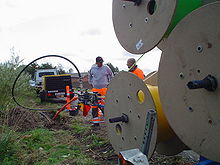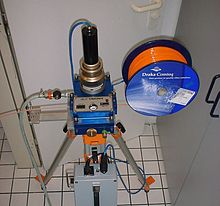- Microducts
-
Microducts are small ducts for the installation of small microduct fibre optic cables. They have a size ranging from typically 3 to 16 mm and are installed as bundles in larger ducts.
Contents
Traditional duct installation
For telecommunications cables can be installed in water, in air or underground. In the latter case the cables might be direct buried or installed in ducts. The first is more common for copper balanced cables, the latter for fibre optic cables. The ducts in which the fibre optic cables are installed are usually made of polyethylene. They have a size ranging from typically 25 mm to 100 mm. Sometimes they are installed as subducts in larger ducts. These larger ducts can also consist of other materials, like concrete. The installation of fibre optic cables in ducts can be done by pulling or by cable jetting.
Problems with fibre optic cables
It is more difficult to make branching fibre optic networks in the access network than it is for copper balanced cables. Splicing optical fibres is much more difficult than connecting copper wires. In Fibre to the Home (FTTH), where a lot of branches are present in the network, an Optical Distribution Network is used to branch the cables from a roadside cabinet or pit that contains optical equipment and is fed from the Central Office
Microduct cabling
With microduct cabling bundles of small microducts are installed in larger protective ducts [1] [2]. This can be done by jetting for example. Bundles of microducts can also be factory pre-installed. The microducts can be branched very easily in the network. At any place of choice a window cut is made in the protective duct and the microduct of choice is cut. This microduct is then connected, using a simple push/pull connector, to a microduct that branches to the desired location. After all connections are made an individual microduct path has been created in the network. A microduct cable can then be jetted through the microduct, without the need to make a splice.
Advantages over traditional cabling
- A branch can be made simply, any place any time.
- Low initial costs.
- The network can grow on demand.
- Easy to install microduct routes in occupied ducts.
- Easy to replace old cables through the network.
- Possibility to migrate from copper balanced cables to fibre optic cables.
Practice
Today the microduct cabling technology is used more and more, all over the world [3]. The fibre counts have grown up to 96 per cable and can be installed in microducts of only 8 mm inner diameter. Bundles of microducts can be jetted over 1500 m or more. Microducts cables can even be jetted over 3.5 km in one single shot [4]. More length without splice is reached by placing jetting equipment in tandem.
References
- Griffioen, W., "Installation of optical cables in ducts", Plumettaz, PTT Research 1993 (ISBN 90-72125-37-1)
- Griffioen, W., Nijstad, H., Grooten, A.T.M., Van Wingerden, A., Brown, G., Hawkins, D.F., Plumettaz, G., "A new, extremely versatile, access network cabling concept for migration to optical fiber", Proc. 45th IWCS, November 1996, page 485-489
- Griffioen, W., Nijstad, H., Grooten, A.T.M., Van Wingerden, A., Brown, G., Hawkins, D.F., Plumettaz, G., "A copper-in-tube access network, easy to migrate to optical fibre", Proc. EC'97 June 1997, page 20-24
- Griffioen, W., Nijstad, H., Grooten, A.T.M., Van Wingerden, A., Brown, G., Hawkins, D.F., Plumettaz, G., "JETnet: versatile access network solutions" Proc. ANCIT Workshop (Eurescom), Torino, 30-31 March 1998
- Griffioen, W., De Oliveira, J., "Metronet - Uma Versátil Rede Óptica de Acesso", Proc. I SIMCRO, Campinas, Brazil (1999)
- Griffioen, W., Van Wingerden, A., Van 't Hul, C., "Versatile outside plant solution for optical access networks", Proc. 48th IWCS, November 1999, page 152-156
- Griffioen, W., Van Wingerden, A., Van 't Hul, C., "Versatile optical access network for business and future consumer market, Proc. EC'99, June 1999, page 69-75
- Griffioen, W., Van Wingerden, A., Van ’t Hul, C., “Univerzální optická přístupová síť pro komerční a budoucí spotřební trh”, Proc. Telecom Symposium, Budweiss (CZ), 8-9 June 1999
- Griffioen, W., Van Wingerden, A., Van 't Hul, C., Lock, P., Van der Tuuk, A., "Innovative solutions for optical access networks", CANTO conference, Willemstad (Curaçao), 28 June - 1 July 2000
- Griffioen, W., Van Wingerden, A., Van 't Hul, C., Lock, P., Van der Tuuk, A., "Innovative solutions for access networks", Proc. 49th IWCS, November 2000, page 538-542
- Griffioen, W., Greven, W., Pothof, T. "A new fiber optic life for old ducts", Proc. 51st IWCS, November 2002, page 244-250
- Griffioen, W., Greven, W., Pothof, T, "Upgrading old ducts for new optical connections", ITG Factagung "Kommunikationskabelnetze", 10-11 December 2002, Köln, Germany
- Griffioen, W., Van Wingerden, A., Van 't Hul, C., Van der Tuuk, A., Crowe, K., "Versatile access to homes using microduct-cabling", FttH Conference (New Orleans), 2003
- Griffioen, W., Van Wingerden, A., Van 't Hul, C., Keijzer, M., "Microduct cabling: Fiber to the Home", Proc 52nd IWCS, November 2003, page 431-437
- Griffioen, W., Van 't Hul, C., Eype, I., Sugito, T., Greven, W., Pothof, T., Khiar, R., De Jonge, L.K., “Microduct cabling at CERN”, Proc 53rd IWCS, November 2004, page 204-211
- Griffioen, W., Zandberg, S., Versteeg, P. M., Keijzer, M., "Blow Simulation Test to Measure coefficient of Friction between (Micro)Duct and cable", Proc. 54th IWCS, November 2005
- Nothofer, K., Griffioen, W., Van Wingerden, A., Berkers, A., Garcia Emeterio, M., Tatat, O., Weiss, A., Storaasli, O., “Experience in the application of various microduct cable designs”, Proc 54th IWCS, November 2005, page 437-442
Categories:- Telecommunications equipment
- Fiber optics
Wikimedia Foundation. 2010.



